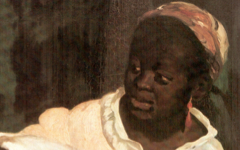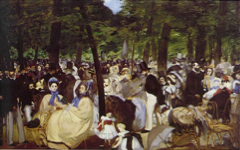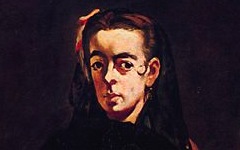Manet’s Argenteuil (1874)

Manet, Argenteuil (1874). Oil on canvas. Musée des Beaux-Arts de Tournai, Belgium
Click image to enlarge.
Argenteuil, brightly colored, is often said to be influenced by Impressionism though the truth is more complex. It pretends to be Impressionist just as Manet's Before the Mirror imitates a picture by Morisot. A contemporary caricaturist insightfully named the two figures ‘Manet and Manette’ and described the Seine behind as a ‘blue wall’. Carol Armstrong, a Manet specialist, agrees that the background ‘flatten[s] the picture out’. She also noted that the couple sit in a very poor rendition of a boat which functions as the painting’s frame.1
Here's why. The man is an "artist"; the woman his "model". The ‘flat’ background is, of course, a ‘painting’ and the foreground ledge is partly a bench in the studio....
Click next thumbnail to continue

Top: Manet, Portrait of Eva Gonzalez (detail rotated)
Bottom: Manet, Argenteuil (detail)
Click image to enlarge.
....The man’s cane is a ‘mahlstick’, the implement artists use to steady their brush hand while painting small details. It is practically identical to the one the painter Eva Gonzales holds in an earlier portrait by Manet (see comparison at left).
Click next thumbnail to continue
Like the grapes in The Railway or the nude in Le Déjeuner, Manet purposely made the boat ‘fail’ to make pictorial sense. He left the Seine out of the Universal Exhibition for the same reason. The awkward passages are needed to create the puzzle. Without them the hidden meaning would remain a thought in Manet’s mind and the images would be lifeless. With the oddities included, Manet's paintings remain mysterious and no surface description, such as describing Le Déjeuner sur l'Herbe as an outdoor picnic, is entirely logical.
Click next thumbnail to continue

L: Manet, Argenteuil (detail)
R: Manet, Portrait of Emile Zola (detail inverted)
Click image to enlarge.
The man himself is the spitting image of Manet's portrayal of the novelist Emile Zola whose own features may have been adjusted to resemble Manet's. In any event, the boatman represents a creative personality, whether Zola's or Manet's.
Click next thumbnail to continue
The woman is emotionally detached from the "artist" because she is his model in the "painting". One is "alive"; the other mere paint. Together, though, fused like the larger subject and studio in Manet's mind they represent the androgyny of his creative soul.
More Works by Manet
Notes:
1. Carol Armstrong, Manet Manette (Yale University Press) 2006, pp. 216-7
Original Publication Date on EPPH: 28 Jan 2011. | Updated: 0. © Simon Abrahams. Articles on this site are the copyright of Simon Abrahams. To use copyrighted material in print or other media for purposes beyond 'fair use', you must obtain permission from the copyright owner. Websites may link to this page without permission (please do) but may not reproduce the material on their own site without crediting Simon Abrahams and EPPH.





